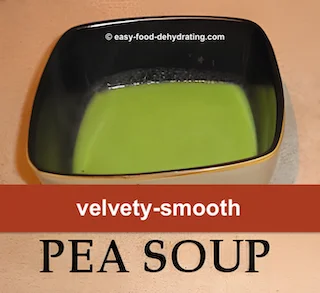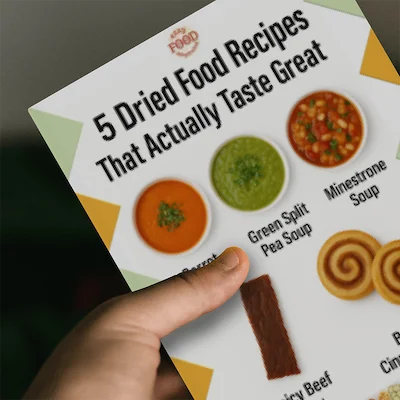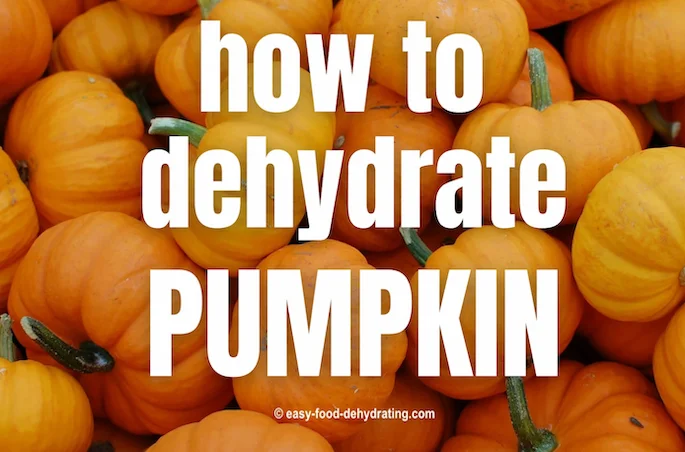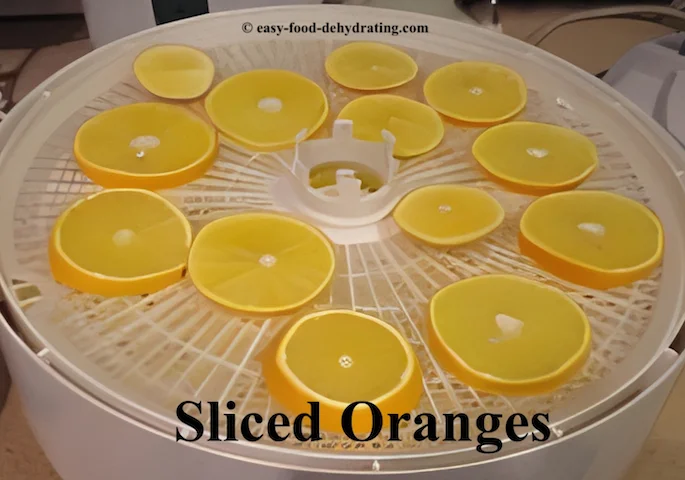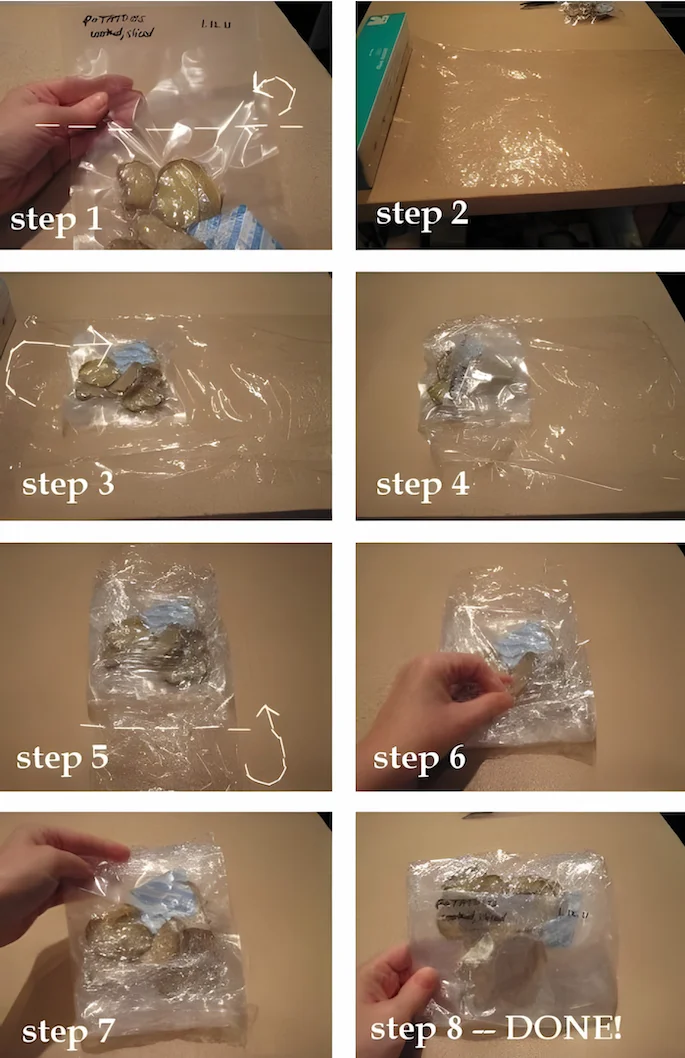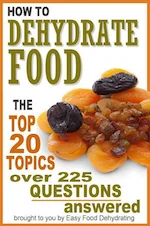- Home
- How to Dehydrate Vegetables
- How to Dehydrate Peas
How to Dehydrate Peas: Easy Steps for Fresh, Frozen & Canned

Susan Gast, Author
Blogger at Easy Food Dehydrating | A New Sober You | Bored Boomers | Beesville Books
Preserving peas is easier than you might think — and dehydrating them is one of the best ways to keep their nutrients intact while extending shelf life. Whether you’ve got fresh-picked garden peas, a bag of frozen ones, or even canned peas, this guide walks you through how to dehydrate them step by step.
✅ Quick Answer: How do you dehydrate peas?
To dehydrate peas, blanch fresh ones or use frozen/canned (already blanched), then spread in a single layer on dehydrator trays. Dry at 125°F–135°F for 8–10 hours until hard and fully dry. Store in airtight containers with oxygen absorbers for long-term freshness.
We’ll also cover how to rehydrate them, storage best practices, and why dried peas are perfect for snacks, soups, or long-term food prep.
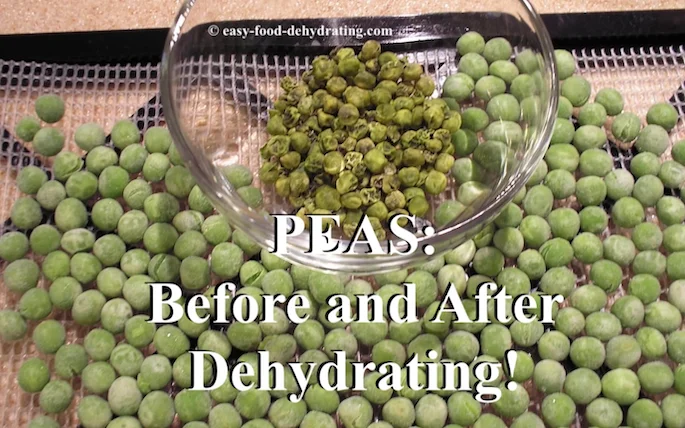
Dehydrated peas are lightweight, shelf-stable, and perfect for long-term food storage, snacking, or adding to soups and stews.
Peas Nutrition Info.
VITAMINS: Vitamin A, followed by Vitamin C, Choline, and Niacin. There are trace amounts of Thiamine, Pantothenic Acid, Riboflavin, Vitamin B6, and Vitamin K.
MINERALS: Good source of Potassium, followed by Phosphorus, Magnesium, and Calcium. They also have trace amounts of Iron, Zinc, Manganese, Copper, and Selenium.
Peas contain Omega-3 and Omega-6 fatty acids.
Peas are also a good source of protein and fiber. When dehydrated, they retain most of their nutritional value and are a convenient and easy-to-store snack.
Step-by-Step: How to Dehydrate Fresh, Frozen, or Canned Peas
How to Dehydrate Fresh Peas
Fresh peas need a little prep before dehydration. Follow these steps:
- Blanch: Boil peas for 2 minutes, then transfer them immediately to ice water to stop cooking.
- Drain & Dry: Spread peas on a towel to remove excess moisture.
- Dehydrate: Arrange peas in a single layer on dehydrator trays.
- Set temperature to 135°F and dry for 8–10 hours or until peas are completely hard.
💡 Pro Tip: Blanching helps peas retain their green color and speeds up drying.
💡 Tip: Outside the U.S.? Most dehydrating temps here are listed in Fahrenheit — use our quick converter to see the Celsius equivalent for your machine.
How to Dehydrate Frozen Peas (The Easiest Method!)


Frozen peas are already blanched, making them the easiest to dehydrate:
- Spread frozen peas evenly on dehydrator trays. Use mesh liners to prevent them from falling through as they shrink.
- Set temperature to 125–135°F. Dry for 8–10 hours until peas are fully dry and firm.
- Store in an airtight container in a cool, dark place.
💡 Tip: Outside the U.S.? Most dehydrating temps here are listed in Fahrenheit — use our quick converter to see the Celsius equivalent for your machine.
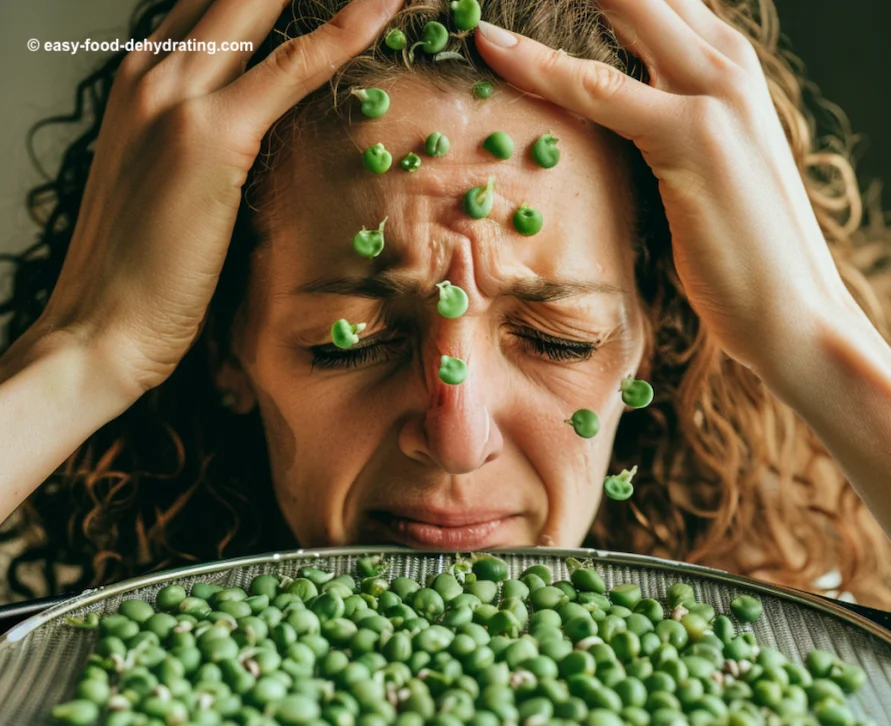
✨ BIG TIP: Use latex gloves when spreading frozen peas to prevent them from sticking to your hands!
Can You Dehydrate Canned Peas?
Yes! However, if long-term storage is your goal, keeping canned peas in their original cans is best. If you still want to dehydrate them:
✔ Drain and rinse the peas to remove excess salt.
✔ Spread them evenly on trays.
✔ Dehydrate at 125–135°F for 8–10 hours.
✔ Store in airtight containers like Mason jars or vacuum-sealer bags.
Handy Tools to Make Dehydrating Peas Easier
I use mesh screens when I'm dehydrating peas to make sure they don't fall through the dehydrator tray openings as they shrivel up when drying.
These screens are readily available where you purchased your dehydrator, and yes, Amazon.com has them!
Nesco ACCESSORIES Available on Amazon
Nesco LSS-2-6 Round clear plastic 13-1/2" diameter Fruit Roll Sheets, white.
- 2 pk of solid fruit roll sheets
- 1.6 sq feet drying area
- Dry capacity up to 3 cups of pureed fruit per sheet
- Check the red Amazon link to see which Nesco models these Fruit Roll Sheets fit
Nesco LM-2-6 Round plastic mesh 13-1/2" diameter Clean-A-Screens, white.
- 2 pk of mesh sheets
- 1.6 sq feet drying area
- Check the red Amazon link to see which Nesco models these Clean-A-Screens fit
Nesco WT-2SG Round Speckled Plastic 13-1/2" diameter Add-A-Tray.
- 2 pk of speckled round trays
- 1.6 sq feet drying area
- Fits 20 Series and 30 Series Food Dehydrators
- Check the red Amazon link to see all the Nesco models these Add-A-Trays fit
As an Amazon Associate, I earn commission from qualifying purchases. The price you pay does not increase. Read disclosure here.
Excalibur ACCESSORIES Available on Amazon
Excalibur 14 x 14 inch Fruit Leather Sheets, beige centers and green outer edges.
- 5 pk of solid sheets
- high-grade silicone, excellent non-stick properties
- Check the red Amazon link to see which Excalibur models these Fruit Leather Sheets fit
Lova brand mesh dehydrator sheets for Excalibur Dehydrators, Cosori Dehydrators, Magic Mill Dehydrators, white.
- 6 pk of mesh sheets, can be cut to fit
- high-grade silicone, excellent non-stick properties
- Check the red Amazon link to see which Excalibur models in particular these mesh screens fit
Excalibur 14 x 14 inch Polyscreen Mesh Tray Screen Inserts (black tray NOT included).
- 9 pk of mesh screen inserts/trays
- 100% FDA Food Grade Material
- Check the red Amazon link to see all the Excalibur models these Excalibur-brand mesh tray sheets fit
As an Amazon Associate, I earn commission from qualifying purchases. The price you pay does not increase. Read disclosure here.
3 Easy Ways to Use Dehydrated Peas in Meals and Snacks
Quick Soak Method: When using dehydrated peas, simply rehydrate by soaking in hot water and let sit for 30 minutes.
Cooking: Add directly to soups, stews, and casseroles—no need to pre-soak!
Snacking: Enjoy plain, season them, or mix into trail mix.
How Long Do Dried Peas Stay Good in Storage?
Dried peas last for a very long time if stored properly. The key to safe food storage is to make sure foods are completely dry before storing them and are at room temperature before placing them in an airtight container and/or vacuum-sealing them.
You don't want heat to cause condensation to form in the sealed bags or Mason jars.
How to Store Dehydrated Peas to Keep Them Fresh
It's important to read all about food vacuum sealers, what they are, and why you should have AND USE one.
For long-term storage, include a 100cc oxygen absorber inside the vacuum-sealer bag before drawing the air out and then sealing the bag.
Oxygen absorbers contain ingredients that react with one another and draw moisture to them. Learn more about the different-sized oxygen absorbers and their uses.
Also consider using desiccant packets - read about those here.
When using Mason jars to store dried peas, include a 100cc oxygen absorber inside your jar of dried peas. Oxygen absorbers are your best friend when dehydrating and storing dried foods.
Top Questions People Ask About Dehydrating Peas
Can you eat dehydrated peas as a snack?
Can you eat dehydrated peas as a snack?
Yes! Dehydrated peas are crunchy, high in fiber and protein, and naturally sweet. Snack on them plain, seasoned, or mixed into trail mixes.
Which types of peas can be dehydrated?
Which types of peas can be dehydrated?
You can dry garden peas, snow peas, black-eyed peas, chickpeas, and canned peas. Just know that canned peas take a little longer due to higher moisture content.
Can I dehydrate peas for planting later?
Can I dehydrate peas for planting later?
Yes, as long as the peas haven’t been cooked or processed. Let them dry completely, then soak before planting.
How do I know when peas are fully dehydrated?
How do I know when peas are fully dehydrated?
Properly dried peas will be hard and shrunken with no moisture or softness. They should not feel tacky or flexible.
What’s the best way to rehydrate dried peas?
What’s the best way to rehydrate dried peas?
Soak in hot water for 30 minutes, or toss directly into soups and stews where they’ll soften as they cook.
Reader Favorite: Creamy Pea Soup Using Dehydrated Peas
Here's a velvety smooth pea soup recipe for you! It's one of my dad's favorite soups I make - with a secret ingredient that makes all the difference!
Also, check out our easy-to-make bread here. After all, you need to have something to dip in the soup... Please visit our recipes page here for more dehydrated food recipes!
Why Dehydrating Peas Is Worth It for Preppers and Home Cooks Alike
Thanks for stopping by to learn how to dehydrate peas!
As you’ve seen, drying peas is a straightforward and satisfying way to preserve them for years — no freezer or fridge required! Whether you're planning ahead for emergencies, whipping up trail mix, or adding flavor to soups, dried peas are a must-have pantry staple.
Don’t forget to grab your free 5 Dried Food Recipes You'll Actually Love PDF (below) — it features some of my favorites like carrot soup, minestrone soup, split pea soup, spicy beef jerky, and banana cinnamon rolls.
Grab 5 Dried Food Recipes You'll Actually Love
Don't forget to grab a copy of our all new
5 Dried Food Recipes (That Actually Taste Great)
They're my all-time favorite easy dried food meals!
Get it here right now.
For Free!
Before You Go...
If you like the content, please give me some love by clicking on the 🩷 in the lower right-hand corner (on just about all my pages). This signals to me that you find it enjoyable and useful.
And don’t forget to grab your FREE 5 Dried Food Recipes via the opt-in form — they're waiting for you! Thank you so much! (Get it here).







